
Welcome to Hyperion Records, a British classical label devoted to presenting high-quality recordings of music of all styles and from all periods from the twelfth century to the twenty-first.
Hyperion offers both CDs, and downloads in a number of formats. The site is also available in several languages.
Please use the dropdown buttons to set your preferred options, or use the checkbox to accept the defaults.

| Sir Stephen Hough (piano)» More |
| Sir Stephen Hough (piano)» More |
| Ignacy Jan Paderewski (piano)» More |
| Michael Zadora (piano)» More |
| Michael Zadora (piano)» More |
| Ignacy Jan Paderewski (piano)» More |
| Moriz Rosenthal (piano)» More |
| Moriz Rosenthal (piano)» More |
| Moriz Rosenthal (piano)» More |
| Moriz Rosenthal (piano)» More |
| Alfred Cortot (piano)» More |
| Aimée-Marie Roger-Miclos (piano)» More |
| Lucien Wurmser (piano)» More |
| Alfred Cortot (piano)» More |
| Vladimir de Pachmann (piano)» More |
| Aleksander Michalowski (piano)» More |
| Aleksander Michalowski (piano)» More |
from notes by Gerald Larner © 2009
extrait des notes rédigées par Gerald Larner © 2009
Français: Hypérion
aus dem Begleittext von Gerald Larner © 2009
Deutsch: Viola Scheffel
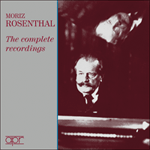 Moriz Rosenthal - The complete recordings Moriz Rosenthal - The complete recordings‘Rosenthal had an inimitably seductive manner of playing … with Ward Marston’s superb restoration and remastering, APR’s exemplary annotation and ... ‘The artistry of Moriz Rosenthal (1862-1946) arguably stands head and shoulders above all recorded Liszt pupils’ (Classics Today)» More |
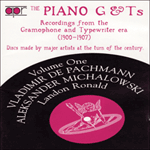 The Piano G & Ts, Vol. 1 - Vladimir de Pachmann, Aleksander Michalowski & Landon Ronald The Piano G & Ts, Vol. 1 - Vladimir de Pachmann, Aleksander Michalowski & Landon Ronald |
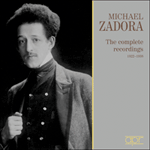 Michael Zadora - The complete recordings Michael Zadora - The complete recordings‘Few of the recordings can be a touch steely in places due to their rarity, but Mark Obert-Thorn ensures that Zadora’s tonal qualities are respected a ... ‘Zadora’s affinity for and commitment to this repertoire certainly cuts through the sonic grime. With so many reissues of reissues of reissues on the ...» More |
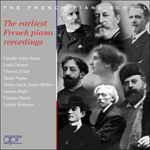 The earliest French piano recordings The earliest French piano recordingsThis set brings together some of the earliest and rarest piano recordings ever made, not just in France, but worldwide, and includes the complete solo recordings of all the pianists featured except Wurmser. The French office of the Gramophone Comp ...» More |
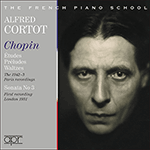 Alfred Cortot - The 1942-3 Paris Chopin recordings Alfred Cortot - The 1942-3 Paris Chopin recordingsAlfred Cortot stands as the greatest representative of 20th-century French pianism. This album focuses on the solo recordings he actually made in France, all recorded in Paris during World War 2, and originally only released locally. These wonderf ...» More |
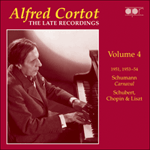 Alfred Cortot – The Late Recordings, Vol. 4 - Schumann, Schubert, Chopin & Liszt Alfred Cortot – The Late Recordings, Vol. 4 - Schumann, Schubert, Chopin & Liszt'Bryan Crimp has done Cortot proud, prompting one to wonder whether there was ever a pianist of greater human richness and coruscating vitality' (Gram ...» More |
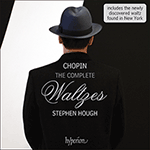 Chopin: The Complete Waltzes Chopin: The Complete WaltzesStephen Hough’s 2011 album of Chopin’s waltzes once more regains its ‘complete’ status with the inclusion of the ‘Valse’ found in a New York library in 2024. Yet further incentive to acquire some Chopin of ‘authority and panache … understanding an ...» More |
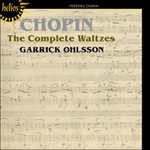 Chopin: The Complete Waltzes Chopin: The Complete Waltzes |
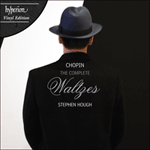 Chopin: The Complete Waltzes - Vinyl Edition Chopin: The Complete Waltzes - Vinyl EditionStephen Hough has a unique affinity for the music of Chopin, whose music has always been a central part of his repertoire. Hough’s name has become synonymous with pianistic elegance, flawless technique and immense musicianship and he has become gl ...» More |
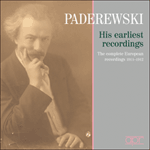 Paderewski - His earliest recordings Paderewski - His earliest recordings |
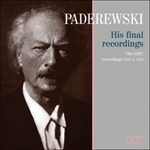 Paderewski - His final recordings Paderewski - His final recordings'Yet even in his 'final recordings' you can glimpse something of an endearing humanity. The free and romantic beauty of Paderewski’s Haydn variations ...» More |
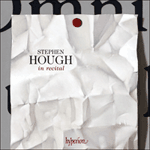 Stephen Hough in recital Stephen Hough in recitalThe Hough discography is enhanced by this delightful recital disc from the winner of the Gramophone Gold Disc Award, acclaimed recently as ‘Britain’s finest pianist’ (The Sunday Times), and as one of the six greatest pianists performing in the wor ...» More |

